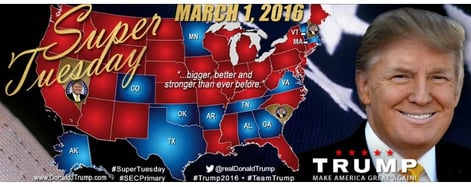 I first wrote about Donald Trump’s mastery of real-time communications back in early August 2015 with my post Donald Trump Winning the Social Networking Primaries in a Landslide.
I first wrote about Donald Trump’s mastery of real-time communications back in early August 2015 with my post Donald Trump Winning the Social Networking Primaries in a Landslide.
This was way before anybody set foot in a polling booth. In my post, I shared detailed analysis on how Trump was way ahead of the other candidates in his use of real-time social media.
The post generated more than 30 comments and several hundred more on social media. Many people said things like, “sure he can use Twitter, but he can’t win”. At the time, mainstream media was not taking a Trump candidacy seriously. Initially I was surprised that I was one of the few to think Trump could actually win the Republican nomination, but then I realized that this is the same exact pattern of resistance to change that everyone goes through when confronted with new ways to market and communicate in our real-time, 24x7, social driven world.
Last night Trump won big in the Super Tuesday primary contests. He won Alabama, Arkansas, Georgia, Massachusetts, Tennessee, Virginia, and Vermont. Together with prior contests, Trump leads the delegate count with 285, more than second place Ted Cruz and third place Marco Rubio combined.
We’re witnessing a marketing and communications revolution
Of course there are many other reasons why Trump enjoys support. As a reality television star, he was already widely known before the primaries. His name is on buildings all over the world. The other Republican candidates have run lackluster campaigns.
But I continue to argue that we’re in a world where the best way to market any product or service – a B2B product, a rock band, your skills as an employee, a consulting service, and yes, a U.S. Presidential campaign – is not the traditional advertising route. A focus on real-time communications gets you noticed. And its free.
The vast majority of senior leaders in the media, the political elite, and yes, executives in companies have been resistant to the revolution. Whenever a revolution occurs, there are always those who cling to the status quo. They want to hang onto power and the old ways of doing things. I see it every day in my research on how organizations do their marketing and sales.
In the marketing world, those who resist the revolution spend millions on ineffective agencies and their “creative” advertising campaigns.
Job seekers obsess over their paper resume and don’t have any content published on the Web.
And yes, the media covers the most engaged candidate, Trump, almost as a joke and refuses to acknowledge that his masterful communications skills can effectively reach people all over the United States.
The revolution is happening. Resist at your peril.
Jeb Bush and the Super Pacs that support him spent tens of millions of dollars on television advertising and generated a tiny handful of delegates. He has since dropped out of the race.
Trump comments on what’s going on in real-time using his incredibly active @realdonaldtrump feed (6.56 million followers) to keep his ideas in front of people. He spends almost no money on ads. Mainstream media loves to report on what Trump says on Twitter which generates tons of free media exposure for the Trump campaign.
The “Trump method” (I call it The New Rules of Marketing and PR), can work for any company, product, or service. Being the most active and engaged can propel your brand ahead of the competition too.
We’re in the middle of a marketing and communication revolution. Are you part of the revolution? Or are you resistant?
Important note: This is a marketing blog, not a political blog. I am not commenting on Trump’s nor any other candidate’s views on the issues. I write about the US Presidential election because it is a massive marketing case study playing out for several years, not because I support any candidate over another.
Image via @realdonaldtrump